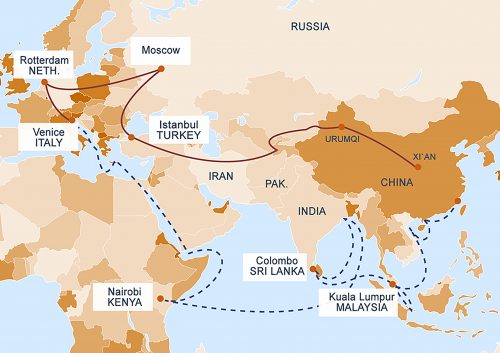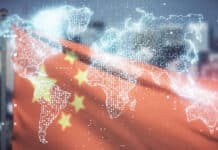China’s Belt and Road Initiative, also known as “One Belt, One Road” (OBOR), is a grand plan to connect East Asia with Europe, the Middle East and Africa via Central and Southeast Asia by means of infrastructure projects. But what are the chances that this ambitious project can create a new Eurasian economic zone which will produce win-win synergies for the countries involved?
The OBOR initiative, officially launched in autumn 2013 by President Xi Jinping in a pair of speeches a month apart, sets out to connect the Eurasian landmass and East Africa by land and sea. This potentially game-changing project has two crucial nodes, both of which require a huge amount of work on the Chinese part, as well as a great deal of cooperation from the numerous potential partners along the way, if the initiative is to come to fruition.
The first is Central Asia, which lies on the overland route from East Asia to Europe. The countries of this region, which include Kazakhstan, Tajikistan, Uzbekistan, Turkmenistan, Kyrgyzstan and others, are rich in natural resources such as oil and natural gas, but are also geo-strategically and geo-economically vital because of their position at the heart of China’s new “Silk Road Economic Belt” (SREB).
Traditionally, having formed part of the Soviet Union up to 1991, the Central Asian nations have tended to fall under Russian influence. China has been trying to work out how to incorporate them into its ambitious plans while also maintaining good relations with Russia, primarily by seeking to encourage positive relations by means of the framework provided by the Shanghai Cooperation Organization (SCO). The fact that President Xi chose to announce the advent of SREB while in Kazakhstan is indicative of the importance that Beijing places on Central Asia as the core of its overland route to Central and Eastern Europe (CEE).
In terms of railways, connections to Europe already exist, but these all pass through Russia on their way to Poland, Germany and beyond. Ideally, China would like to develop one or more routes which would bypass Russia (for instance by passing through Central Asia,t Iran and Turkey, although work on such a route has not yet progressed beyond the drawing board), and to build new high-speed rail connections which would speed up transit times and encourage more trade.
[ms-protect-content id=”3162″]
The second node is a nautical route termed the “21st century Maritime Silk Road” (MSR). This attempts to connect the South China Sea with the Mediterranean via the Indian Ocean and the Red Sea. The route is vital because huge amounts of oil, liquid natural gas (LNG), raw materials and manufactured goods pass through the narrow chokepoint that is the Straits of Malacca on their way to and from China and other East Asian states such as South Korea and Japan.
China is therefore attempting to exercise greater control over the route by creating a “string of pearls” of major new ports through the Indian Ocean region (IOR) and beyond. With Chinese construction and development ongoing at Piraeus in Greece, Kumport in Turkey, Suez in Egypt, Bagamoyo in Tanzania, Gwadar in Pakistan, Kyaukpyu in Myanmar, and Hambantota and Colombo in Sri Lanka, there is a clear potential to create a network of Chinese-funded commercial harbours which will, in the economic jargon, “float all boats”.
However, whether a new transport and infrastructure web of this type will succeed is as yet far from certain, due chiefly to logistical uncertainties arising from having to work with a wide range of partner countries run by regimes of assorted political backgrounds. China this year for instance suffered a setback when the Chinese plan for a deep-sea port in Bangladesh was this year shelved by the Bangladeshi government, knocking one of the pearls out of the proposed string. Doubts in Sri Lanka and Greece about the wisdom of allowing China to invest in major infrastructure in their countries also persist despite the fact that port construction has thus far been permitted to continue.
Problems, Problems
What are the odds of a potentially visionary and transformative project as OBOR being realised? At first glance they appear to be less than ideal, given the incredible costs, potential for misunderstandings, and numerous other obstacles which undoubtedly need to be overcome in joining together 64 disparate nations (for such is the official head count of countries included by Beijing in the Belt and Road initiative) in a coherent network of trading states.
Of course, the British managed to construct infrastructure such as railways, roads and ports to connect their empire in the eighteenth, nineteenth and twentieth centuries, so there is at least one precedent for a sprawling trade network covering half the world. However, the main difference between the empire on which the sun never set and China’s “New Silk Road” is that London exercised a high degree of geopolitical and geo-economic control via its armed forces (particularly its navy), advanced technology (such as guns and ships), and sophisticated trading instruments (such as its stock market and East India Company) of which Beijing can so far only dream.
There is clearly therefore a danger of China taking on too much, too fast. Lack of global experience and local know-how may lead to failures such as the collapse of a highway construction project in Poland in 2011 due to misunderstandings between the Chinese constructor and Polish authorities. It therefore ought to be assumed that culture clashes and bureaucratic issues are likely to stymie at least some of the necessary cooperation entailed in advancing OBOR towards completion if both China and its partners do not take the time to do proper risk analysis before commencing individual projects.
There is also the associated problem of China lacking both a sufficient number of genuine allies and the degree of soft power to make its grand scheme come to pass. Beijing has relatively good relations with a few influential neighbours such as Russia, South Korea and Pakistan (despite occasional hiccups even in these cases), but has managed to alienate (to one extent or another) most of Southeast Asia, as well as the US, by means of its island-grabbing actions in the South China Sea. Japan and India are notably also not exactly friends of the Middle Kingdom, since both are worried by territorial disputes, while Europe remains suspicious of Beijing’s human rights record and actions in Tibet. In terms of soft power attraction, despite its ostensibly fat wallet China simply cannot yet get close to competing with Western countries such as the US and the UK, whose movies, music and sports still dominate global culture. Given that its authoritarian one-party political system does not appear to be much of a selling point either for most people in either the developed or the developing world, China clearly has a lot to do in terms of advancing the aims of its so-called “charm offensive”.
Many observers also regard OBOR as vague and nebulous rather than representing a clear and coherent vision. It is true that there has been something of a lack of specificity so far on how individual infrastructure projects are intended to link up. So there are certainly doubts about whether Beijing can lift the Belt and Road initiative to a level beyond lofty rhetoric and establish it as a fully-integrated trade and infrastructure network.
Finally there is a question mark concerning the depth of China’s pockets and the prospects for continuing growth in its economy. Are the nation’s coffers really capable of sustaining the spending necessary to connect the world’s largest contiguous land mass via masses of new infrastructure? There have already been questions raised in some quarters concerning promises of funding that appear unlikely to materialise in full (such as the promise of $10 billion in loans for CEE in 2014). China will need to be sure that its partners not only believe its promises, but also that it can follow through financially.
The Rose-Tinted Version
On the other hand, OBOR’s defenders can point to its record on the ground thus far in turning words into action. In early 2016 the Chinese shipping company COSCO completed its purchase of a majority stake in the port of Piraeus in Greece after rapidly establishing it as one of the top ten container shipping hubs in Europe since taking over on a lease in 2009. Three pipelines for natural gas already snake their way from Central Asia through to Xinjiang in northwest China, with a fourth (to connect the other three) in the planning stages. Work on the China-Pakistan Economic Corridor (CPEC) is progressing, with the intention of transporting Persian Gulf oil up from Gwadar through Pakistan to Xinjiang, thus bypassing the Malacca chokepoint. Further east, a similar corridor, Bangladesh-China-India-Myanmar (BCIM), is also being established. In East Africa, China is building dams (for hydroelectric power), roads, railways, ports and power stations, and this activity is beginning to impact local economies positively.
Beijing can also point to the multilateral institutions it has set up to finance and enable OBOR projects. Apart from the SCO and the $40 billion Silk Road Fund, there is the $100 billion Asian Infrastructure Investment Bank (AIIB) which has 37 founding members including the UK, Germany and Australia: China has put up half of the initial funding for the bank, which is intended as an alternative to the US-based World Bank. In Central and Eastern Europe, China’s 16+1 forum for meetings between Chinese leaders and their counterparts from 16 CEE countries has rapidly gained traction since its inception in Warsaw in 2012, and is steadily improving Beijing’s relations with the region it sees as an OBOR entry point to Europe. China is also involved in a Regional Comprehensive Economic Partnership (RCEP) to create a free trade zone between 16 Asia-Pacific states.
So despite the doubts over financing, politics and global know-how listed in the previous section, it is clear that China is putting both its money and the construction expertise of its companies where its mouth is. The question is whether the progress made so far can be maintained and accumulated into a coherent whole which will genuinely change Eurasia-Africa into an integrated, Chinese-led trade zone.
Prospects for Success?
Given China’s growing influence in Asia and in the world economy, and the nation’s more than $3 trillion in foreign exchange reserves, it would not appear wise to bet against its ability to make an increasing impact on the nations of Eurasia and Africa as it shifts its focus westwards. The European Union is already China’s biggest trading partner, so it is a natural progression for Beijing to seek further integration via a transport and infrastructure network. Geo-economically speaking, as Chinese scholars and officials repeatedly emphasise, making these connections via Central Asia, the IOR, the Middle East and East Africa makes sense if these regions can be properly linked.
Nevertheless, the obstacles to establishing OBOR as a genuine whole appear massive. Culture, bureaucracy, local politics, terrorism, cash flow problems and many other factors could all play their part in derailing China’s grand plan.
However, in the end, there are two compelling reasons for the world’s doubting Thomases to develop sufficient faith in OBOR to participate at least half-heartedly. The first is that it is better to be involved than not, just in case the vision does become reality. That way nations can be at the forefront of development rather than left behind.
The second is that China’s vision for a new Eurasian economic zone may well be the best long-term bet going, given that the Western powers such as the EU and the US have not come up with anything of equivalent breadth and ambition. If the world’s economic geography is going to change in the 21st century, with a continuing shift of the centre of geo-economic (and eventually geopolitical) gravity to East Asia (as seems likely), then OBOR may just represent a major chunk of this transformation, and therefore merits the investment of at least a bit of time, attention and money.
[/ms-protect-content]About the Author
Jeremy Garlick lectures on the international relations of China at the Jan Masaryk Centre for International Studies, Faculty of International Relations, at the University of Economics Prague. He specialises in China-Europe relations, with a particular focus on China-CEE relations, and also on theories of China’s rise. His doctoral thesis explored China’s future through scenarios. He has spent six years teaching at universities in mainland China and South Korea.
















































